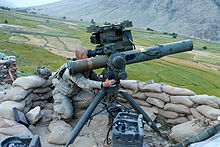Top-attack: Difference between revisions
formatting |
short description update |
||
| Line 1: | Line 1: | ||
{{Short description|Top-attack is a method |
{{Short description|Top-attack is a weapon employment or targeting method, usually used against armoured vehicles.}} |
||
A '''top attack''' weapon is designed to attack [[Armoured fighting vehicle|armoured vehicle]]s from above as a form of '''plunging fire''', as the [[armour]] is usually thinnest on the top of the vehicle. Ideally, it will penetrate [[perpendicular]] to the attacked surface. The device may be delivered (often as a [[submunition]]) by an [[anti-tank guided missile]], [[mortar (weapon)|mortar]], [[artillery]] [[shell (projectile)|shell]], or even an emplaced [[munition]] such as a mine. Top attack munitions use either a [[high-explosive anti-tank]] (HEAT) warhead for direct impact or near impact, or an [[explosively formed penetrator]] (EFP) warhead fired while over the target. |
A '''top attack''' weapon is designed to attack [[Armoured fighting vehicle|armoured vehicle]]s from above as a form of '''plunging fire''', as the [[armour]] is usually thinnest on the top of the vehicle. Ideally, it will penetrate [[perpendicular]] to the attacked surface. The device may be delivered (often as a [[submunition]]) by an [[anti-tank guided missile]], [[mortar (weapon)|mortar]], [[artillery]] [[shell (projectile)|shell]], or even an emplaced [[munition]] such as a mine. Top attack munitions use either a [[high-explosive anti-tank]] (HEAT) warhead for direct impact or near impact, or an [[explosively formed penetrator]] (EFP) warhead fired while over the target. |
||
Revision as of 12:58, 7 May 2024
A top attack weapon is designed to attack armoured vehicles from above as a form of plunging fire, as the armour is usually thinnest on the top of the vehicle. Ideally, it will penetrate perpendicular to the attacked surface. The device may be delivered (often as a submunition) by an anti-tank guided missile, mortar, artillery shell, or even an emplaced munition such as a mine. Top attack munitions use either a high-explosive anti-tank (HEAT) warhead for direct impact or near impact, or an explosively formed penetrator (EFP) warhead fired while over the target.
The top attack concept was first put into service by the Swedish Armed Forces in 1988 with the Bofors RBS 56 BILL top-attack anti-tank missile.[1]
Weapon systems using top attack



Notable weapon systems that utilize top attack include:
| Weapon system | Country of origin |
|---|---|
| AGM-114 Hellfire | Vereinigte Staaten |
| AT-1K Raybolt | Südkorea |
| BGM-71F/TOW-2B | Vereinigte Staaten |
| BLU-108 | Vereinigte Staaten |
| CBU-97 Sensor Fuzed Weapon | Vereinigte Staaten |
| FGM-148 Javelin | Vereinigte Staaten |
| Griffin LGB | Israel |
| HJ-12 | China |
| Kitolov-2M | Russian Federation |
| KM-8 Gran | Russian Federation |
| Krasnopol | Russian Federation |
| KSTAM | Südkorea |
| LAHAT | Israel |
| M93 Hornet mine | Vereinigte Staaten |
| Mokopa | Südafrika |
| MPATGM | Indien |
| Nag | Indien |
| OMTAS | Türkei |
| PARS 3 LR | Deutschland |
| Prospina | Indien |
| RBS 56 BILL | Schweden |
| RBS 56B BILL 2 | Schweden |
| SADARM | Vereinigte Staaten |
| SMArt 155 | Deutschland |
| Spike | Israel |
| Strix mortar round | Schweden |
| Toophan 3M | Iran |
| Type 01 LMAT | Japan |
| XM395 Precision Guided Mortar Munition | Vereinigte Staaten |
See also
References
- ^ "RBS 56 BILL". robotmuseum.se (in Swedish). Retrieved February 26, 2022.
